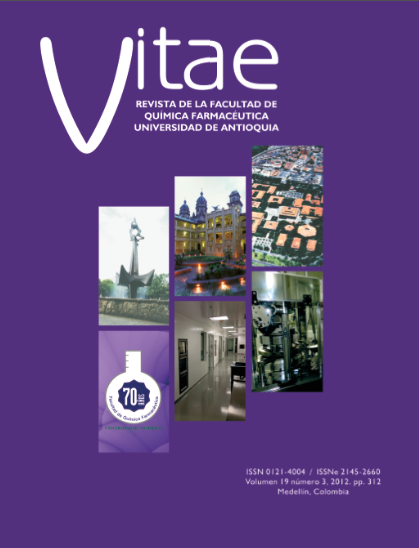EVALUATION OF THE INDUCTION OF LIPOLYTIC ENZYMES FROM A Pseudomona aeruginosa ISOLATED FROM AFRICAN PALM FRUIT (Elaeis guineensis)
DOI:
https://doi.org/10.17533/udea.vitae.10860Keywords:
Lipolytic activity, fatty acids, enzyme induction, hydrolysis.Abstract
Background: Extracellular lipases are found in the culture broth when the fermentation is at the end of the exponential phase. Lipases can be induced easily since they are produced by the presence of oily sources or other materials as surfactants, fatty acids, some esters, glycerol and biliary salts. Objective: The aim of this work is to study the effect of carbon source concentration and the use of inductors on biomass production, and the lipolytic activity of a bacterium isolated from mature palm oil fruits. Methods: The yield biomass/substrate was evaluated with glucose as carbon source at different concentrations (3, 5, 7, 10, 15 y 20 g/L) by dry weight and OD (600 nm). Lipolytic activity was evaluated by spectrophotometric assay using p-nitrofenilpalmitate at 37°C for 15 min. Results: Gram negative microorganisms with lipolytic activity isolated from palm fruit were identified as Pseudomona aeruginosa. The growth of the bacteria was inhibited when glucose was used at concentrations greater than 5%. The production of lipase was induced by using three inducers (Palm oil, Tween 20 and palm oil:Tween 20 mixture), at three different induction times (0, 11 and 18 hours of fermentation). The highest activity (3,81 µmoles/ mL*min) was observed when the palm oil:Tween 20 mixture was added at 11 hours of fermentation. The kinetic of p-nitrophenylpalmitate hydrolysis using the supernatant of a culture induced with palm oil:Tween 20 mixture at 11 hours showed the production of p-nitrophenol beyond 300 minutes, with the greatest hydrolysis rate during the first 7 minutes. Conclusions: The growth of P. aeruginosa was not affected by using glucose as carbon source at concentrations of 3% and 5%. There was a basal level of lipase production without inducer, and greater lipolytic activity was achieved with the addition of inducers.
Downloads
Downloads
Additional Files
Published
How to Cite
Issue
Section
License
Copyright Notice and Open Access Statement
The Journal Vitae works under the Open Access license, and the published manuscripts remain available for the public, both on the Journal's website and in databases, under the Creative Commons license, "Noncommercial Attribution" and "Share alike" systems, adopted in Colombia. Hence, when the authors agree to publish in the Journal Vitae, they will not have the right to economic retributions on publications and reproductions through different diffusion media. The documents are freely available to the internet public, permitting users to read, download, copy, distribute, print, search, or link to the full texts and pass them as data to software. The only constraint on reproduction and distribution, should be to give authors control over the integrity of their work and the right to be appropriately acknowledged and cited.
Authors declare that:
-
They are the intellectual property owners and are responsible for all the information stated in the article.
-
This manuscript has not been submitted or published in other printed or digital media. They accept the responsibility for the judgments, opinions, and points of view expressed in the published article and, therefore, they exonerate Universidad de Antioquia and Journal Vitae from any process.
-
They exempt Universidad de Antioquia and Journal Vitae from settling conflicts or disputes related to the authorship of the referred article.
-
They accept the revision of the original manuscript by suitable personnel, and they bind themselves to perform the corrections appointed or suggested by the assessors.
-
Therefore, they know the editorial process and will not bind the Editorial Board of the Journal to assume any obligations regarding the volume and issue in which the article is published.
-
They transfer the rights of publication, reprinting, and distribution of the article from the moment of its approval, in print and digital format, without the right to economic rewards, and under the licensing conditions considered relevant by Journal Vitae.
-
They fully authorize Universidad de Antioquia and Journal Vitae to submit the published material to the diverse databases and indexing systems where the Journal can be found to comply with the requirements of the regulatory authorities to maintain the national classification of journals.
-
They will assume the article publication costs established for the current issue, and they will make the payment as soon as they are informed about the volume and the issue in which the final version of the article is published.
-
After the article is published, you can share digital or printed copies in a noncommercial manner. You will be able to use the paper in your institution or company for educational or research purposes, including the use in course programs.
Conflict of interest: Authors are responsible for recognizing and disclosing any financial or other benefits that could be perceived to bias their work, acknowledging all financial support and any personal connections with potential sponsors. Examples of such conflicts include receiving research funds or honoraria, serving on advisory boards, stock ownership, or employment and consulting arrangements. Authors without such connections should clearly state that they have no financial support or personal relationships that could be perceived to bias their work. All conflicts of interest should be disclosed on the author's identification page of the manuscript.










